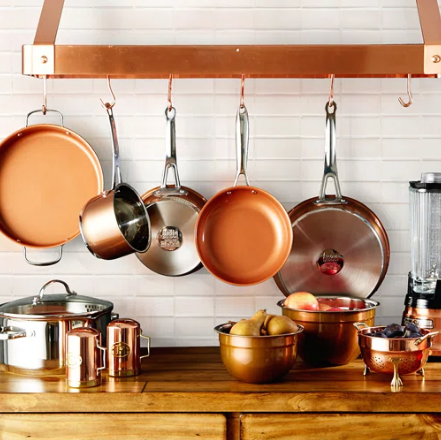
A Guide to Cooking Pans by Shape and Usage
Share
Different cooking pans have distinct shapes that make them ideal for specific tasks. Whether you’re a home cook or a professional chef, understanding these differences helps you choose the right pan for searing, sautéing, simmering, or braising.
We’ll explore key pan types—skillets, sauté pans, saucepans, sautéuses, woks, and stockpots—as well as a couple of specialty pans like the paella pan and tagine. For each, we’ll cover shape, usage, and pros & cons.
Skillet (Frying Pan)
Shape: Flat-bottomed with flared, sloped sides. Usually lightweight with a long handle and no lid.
Uses: Excellent for searing, sautéing, pan-frying, stir-frying, and oven-baking (if oven-safe).
Pros:
-
Easy to toss food for even browning
-
Great access for stirring and flipping
-
Lightweight and maneuverable
Cons:
-
Not ideal for simmering liquids
-
Smaller flat cooking area compared to sauté pans
-
Often sold without a lid
🛒 Looking for a high-quality carbon steel skillet? Check out our 27cm Carbon Steel Pan or the larger 30cm version – both combine responsive carbon steel with the classic skillet design.
Sauté Pan (Straight-Sided)
Shape: Flat, wide base with tall, straight sides. Comes with a lid and often a helper handle.
Uses: Ideal for braising, shallow frying, reducing sauces, and stovetop-to-oven dishes.
Pros:
-
Larger surface area than a skillet
-
Contains liquids and reduces splatter
-
Great for saucy one-pan meals
Cons:
-
Heavier than a skillet
-
Not ideal for toss-motion cooking
-
Tall sides can slow down reduction slightly
👉 Compare skillets and sauté pans
Saucepan
Shape: Deep, straight sides with a relatively small base and a long handle. Usually 2–4 quarts in size.
Uses: Perfect for sauces, soups, grains, custards, and boiling small batches of pasta or eggs.
Pros:
-
Excellent heat distribution for liquids
-
Lids help retain or reduce moisture
-
Easy to pour with spout or rolled edge
Cons:
-
Too small for family-sized batches
-
Narrow base limits surface for browning
-
Food can stick in sharp corners
👉 Saucepan vs. Saucier explained
Sautéuse (Chef’s Pan)
Shape: Wide base with gently sloping sides and a lid. A cross between a skillet and a sauté pan.
Uses: Great for one-pan meals like risotto, stir-fries, pasta dishes, and shallow braising.
Pros:
-
Easy to stir and toss thanks to curved sides
-
Slightly deeper than a skillet for saucy dishes
-
Oven-safe and usually comes with a lid
Cons:
-
Less specialized than other pans
-
Can be bulky to store
-
May be sold under different names (chef’s pan, everyday pan)
Wok
Shape: Deep, rounded bowl with high, sloping sides. Classic round-bottom versions require a wok ring; flat-bottom options work on most stoves.
Uses: Ideal for stir-frying, deep-frying, steaming, boiling, and smoking.
Pros:
-
Handles high heat for true wok hei flavor
-
Cooks large portions with small stovetop footprint
-
Versatile enough to replace multiple pans
Cons:
-
Learning curve and seasoning required
-
Best used with gas burners
-
Bulky to store and clean
Stockpot
Shape: Tall, deep pot with a wide diameter and two loop handles. Typically 6–12 quarts for home kitchens.
Uses: Soups, stocks, chili, pasta boiling, seafood boils, and home canning.
Pros:
-
Huge capacity for feeding a crowd
-
Minimizes evaporation for long simmers
-
Stable with loop handles for safe lifting
Cons:
-
Not efficient for small batches
-
Can scorch thick mixtures if stirred infrequently
-
Bulky and slow to heat
Specialty Pans
Paella Pan
Shape: Extremely wide and shallow with sloped sides and two loop handles.
Uses: Designed for cooking paella, where a broad surface ensures even rice cooking and socarrat development.
Pros:
-
Ideal for rice dishes with even evaporation
-
Responsive to temperature changes
-
Great for family-style serving
Cons:
-
Limited use beyond flat dishes
-
Doesn’t retain liquids well
-
Can be too large for small stovetops
👉 Why paella needs a paella pan
Tagine
Shape: Shallow base with a tall conical lid that traps steam and returns it to the food.
Uses: Traditional Moroccan-style stews with minimal liquid. Ideal for low-and-slow braising.
Pros:
-
Self-basting design for tender, moist results
-
Beautiful for serving
-
Energy-efficient for long cooks
Cons:
-
Not for high-heat cooking
-
Fragile if made from traditional clay
-
Requires storage space and care
Final Thoughts
Understanding pan shapes helps you make smarter cookware choices. The quick-tossing skillet, the sauce-loving saucepan, the multitasking sauté pan, or the specialized tagine, all have their purpose.
Whether you’re building your first cookware set or upgrading to something better, start with tools that match how you cook.
And if you’re looking to level up your kitchen, our 27cm and 30cm carbon steel sauté pans are ideal all-rounders built for daily use.
Happy cooking!